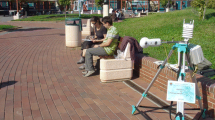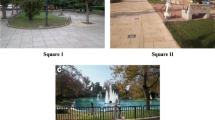Abstract
The present paper is the second part of our study in which we compare the results obtained in Szeged (Hungary) with those achieved through earlier outdoor thermal comfort projects based on simultaneous questionnaire surveys and on-site meteorological measurements. The main characteristics of the selected studies—conducted in Hungary, Sweden, Portugal, Canada, Taiwan and across Europe in the frame of project RUROS—are reviewed, emphasizing the common features and also the discrepancies in the applied methodology. We discuss their potential effects on the evolution and interpretation of the results concerning the subjective assessment of the thermal environment. Another aspect of the comparison focuses on the regional climatic differences naturally ensuing from the various locations, which left their marks on the results related to both physiological acclimatization and mental adaptation. The compared results of different studies include correlation coefficients expressing interrelationships between the different aspects of subjective estimations (thermal sensation, perceptions, preferences) and also between subjective assessments and the corresponding meteorological parameters. We compare neutral temperatures (expressed in physiological equivalent temperature, PET) which arose for Taiwan and Hungary, as well as thermal sensation zones for local inhabitants. Subjectively assessed temperature values of Sweden and Hungarians are analyzed according to the measured air temperature. According to our experiences the methodology should be standardized for the level of field surveys and also for the level of data processing in order to make the data collected in different locations comparable.



Similar content being viewed by others
References
Andrade H, Alcoforado MJ (2008) Microclimatic variation of thermal comfort in a district of Lisbon (Telheiras) at night. Theor Appl Climatol 92:225–237
Brager GS, de Dear RJ (1998) Thermal adaptation in the built environment: a literature review. Energy Build 27:83–96
Central Weather Bureau (2011) Climate statistics. http://www.cwb.gov.tw/V7e/climate/monthlyMean/tx.htm. Accessed July 2011
Deb C, Ramachandraiah A (2010) Evaluation of thermal comfort in a rail terminal in India. Build Environ 45:2571–2580
Eliasson I, Knez I, Westenberg U, Thorsson S, Lindberg F (2007) Climate and behaviour in a Nordic city. Landscape Urban Plan 82:72–84
Fanger PO (1972) Thermal comfort. McGraw Hill, New York, p 244
Fiala D, Havenith G, Bröde P, Kampmann B, Jendritzky G (2011) UTCI-Fiala multi-node model of human heat transfer and temperature regulation. Int J Biometeorol. doi:10.1007/s00484-011-0424-7
Fountain M, Brager G, de Dear RJ (1996) Expectations of indoor climatic control. Energy Build 24:179–182
Höppe P (1988) Comfort requirements in indoor climate. Energy Build 11:249–257
Höppe P (1992) Ein neues Verfahren zur Bestimmung der mittleren Strahlungstemperatur in Freien. Wetter und Leben 44:147–151
Höppe P (1993) Indoor climate. Experientia 49:775–779
Höppe P (1999) The physiological equivalent temperature—an universal index for the biometeorological assessment of the thermal environment. Int J Biometeorol 43:71–75
Jendritzky G, Sönning W, Swantes HJ (1979) Ein objektives Bewertungsverfahren zur Beschreibung des thermischen Milieus in der Stadt- und Landschaftsplanung (Klima-Michel-Modell). ARL Beiträge 28
Kántor N, Égerházi L, Unger J (2012) Subjective estimations of thermal environment in recreational urban spaces—Part 1: investigations in Szeged, Hungary. doi:10.1007/s00484-012-0523-0
Kántor N, Unger J (2010) Benefits and opportunities of adapting GIS in thermal comfort studies in resting places: an urban park as an example. Landscape Urban Plan 98:36–46
Knez I, Thorsson S (2006) Influences of culture and environmental attitude on thermal, emotional and perceptual evaluations of a public square. Int J Biometeorol 50:258–268
Knez I, Thorsson S, Eliasson I, Lindberg F (2009) Psychological mechanisms in outdoor place and weather assessment: towards a conceptual model. Int J Biometeorol 53:101–111
Lenzholzer S, Koh J (2010) Immersed microclimatic space: microclimate experience and perception of spatial configurations in Dutch squares. Landscape Urban Plan 95:1–15
Lin TP (2009) Thermal perception, adaptation and attendance in a public square in hot and humid regions. Build Environ 44:2017–2026
Lin TP, Matzarakis A (2008) Tourism climate and thermal comfort in Sun Moon Lake, Taiwan. Int J Biometeorol 52:281–290
Matzarakis A, Mayer H (1996) Another kind of environmental stress: thermal stress. WHO News 18:7–10
Matzarakis A, Mayer H, Izomon MG (1999) Application of a universal thermal index: physiological equivalent temperature. Int J Biometeorol 43:76–84
Matzarakis A, Rutz F, Mayer H (2007) Modelling radiation fluxes in simple and complex environments—application of the RayMan model. Int J Biometeorol 51:323–334
Matzarakis A, de Rocco M, Najjar G (2009) Thermal bioclimate in Strasbourg—the 2003 heat wave. Theor Appl Climatol 98:209–220
Matzarakis A, Rutz F, Mayer H (2010) Modelling radiation fluxes in simple and complex environments: basics of the RayMan model. Int J Biometeorol 54:131–139
Mayer H (1996) Human-biometeorologische probleme des stadtklimas. Geowissenschaften 14(6):233–239
Mayer H (2008) KLIMES—a joint research project on human thermal comfort in cities. Ber Meteor Inst Univ Freiburg 17:101–117
Mayer H, Höppe P (1987) Thermal comfort of man in different urban environments. Theor Appl Climatol 38:43–49
Mayer H, Holst J, Dostal P, Imbery F, Schindler D (2008) Human thermal comfort in summer within an urban street canyon in Central Europe. Meteorol Z 17:241–250
McIntyre DA (1980) Indoor climate. Applied Science Publishers, London
Morgan C, de Dear R (2003) Weather, clothing and thermal adaptation to indoor climate. Clim Res 24:267–284
Nikolopoulou M, Steemers K (2003) Thermal comfort and psychological adaptation as a guide for designing urban spaces. Energy Build 35:95–101
Nikolopoulou M, Baker N, Steemers K (2001) Thermal comfort in outdoor urban spaces: understanding the human parameter. Sol Energy 70:227–235
Nikolopulou M, Lykoudis S (2006) Thermal comfort in outdoor urban spaces: analysis across different European countries. Build Environ 41:1455–1470
Nikolopulou M, Lykoudis S (2007) Use of outdoor spaces and microclimate in a Mediterranean urban area. Build Environ 42:3691–3707
Oliveira S, Andrade H (2007) An initial assessment of the bioclimatic comfort in an outdoor public space in Lisbon. Int J Biometeorol 52:69–84
Nikolopoulou M (Project coordinator) (2011) RUROS: rediscovering the urban realm and open spaces. http://alpha.cres.gr/ruros/. Accessed July 2011
Spagnolo J, de Dear R (2003) A field study of thermal comfort in outdoor and semi-outdoor environments in subtropical Sydney, Australia. Build Environ 38:721–738
Stathopoulos T, Wu H, Zacharias J (2004) Outdoor human comfort in an urban climate. Build Environ 39:297–305
The Weather Network (2011) Weather statistics. http://www.theweathernetwork.com/statistics/suncloud/cl7025250/caqc0363. Accessed July 2011
Thorsson S, Lindqvist M, Lindqvist S (2004) Thermal bioclimatic conditions and patterns of behaviour in an urban park in Göteborg, Sweden. Int J Biometeorol 48:149–156
VDI (1998) Methods for the human-biometeorological assessment of climate and air hygiene for urban and regional planning. Part I: Climate. VDI 3787, Part 2. Beuth, Berlin, p 29
WMO (1996) Climatological normals (CLINO) for the period 1961–1990. WMO/OMM-No. 847. Secretariat of the World Meteorological Organization, Geneva, Switzerland
Acknowledgment
This study was supported by the TÁMOP-4.2.2/B-10/1-2010-0012. Thanks to E. Tanács for the language corrections, and to reviewers for their constructive recommendations.
Author information
Authors and Affiliations
Corresponding author
Rights and permissions
About this article
Cite this article
Kántor, N., Unger, J. & Gulyás, Á. Subjective estimations of thermal environment in recreational urban spaces—Part 2: international comparison. Int J Biometeorol 56, 1089–1101 (2012). https://doi.org/10.1007/s00484-012-0564-4
Received:
Revised:
Accepted:
Published:
Issue Date:
DOI: https://doi.org/10.1007/s00484-012-0564-4




